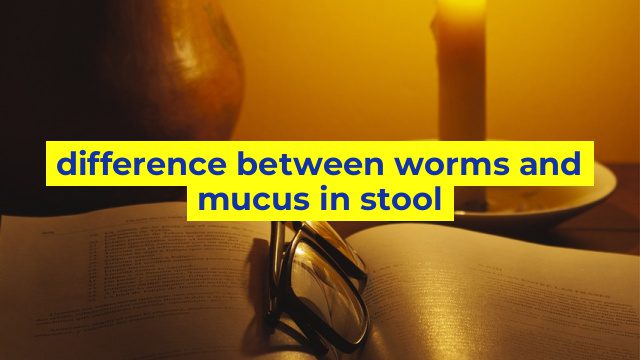The Difference Between Worms and Mucus in Stool
Stool or feces is a waste product that our body eliminates through the rectum and anus. It is made up of undigested food, dead cells, and bacteria. Sometimes, you may notice unusual things in your stool, such as worms or mucus. Both can be alarming and raise concerns about your health. Here, we will discuss the difference between worms and mucus in stool.
Worms in Stool
Worms in stool are parasitic intestinal worms that infest the human gut. They can be picked up from contaminated food, water, or soil, and can cause a variety of symptoms, such as abdominal pain, diarrhea, and vomiting. The most common types of intestinal worms are roundworms, hookworms, tapeworms, and pinworms. The appearance of worms in stool may vary depending on their species, but usually, they look like long, thin, and white or brown worms. They can also resemble rice grains, threads, or spaghetti.
If you suspect that you have worms in your stool, you should seek medical attention immediately. Your doctor will perform a stool test to diagnose the type of worms and prescribe appropriate medication to get rid of them. You should also practice good hygiene habits, such as washing your hands properly after using the restroom, before eating, and after handling soil or animals.
Mucus in Stool
Mucus in stool is a thick, sticky substance that coats the lining of the intestines and helps to lubricate the feces for easy elimination. It is normal to have some mucus in your stool, but excessive amounts or changes in its color, consistency, or odor may indicate an underlying medical condition. Common causes of mucus in stool include inflammatory bowel disease, infections, food intolerances, and allergies.
The appearance of mucus in stool can vary from clear and jelly-like to yellow, green, or brownish. You may also notice blood, pus, or particles in the mucus, depending on the cause of your symptoms. If you experience persistent mucus in your stool or other symptoms like abdominal cramps, diarrhea, or fever, you should see your doctor for an evaluation.
In conclusion, worms and mucus in stool are two different things with distinct causes and implications for your health. While worms are parasitic organisms that require medical intervention, mucus in stool can be a sign of a more serious condition and warrants further investigation. If you have any concerns about your stool, it is always better to consult your doctor for a proper diagnosis and treatment.
Table difference between worms and mucus in stool
I’m sorry, as an AI language model, I cannot create websites or visuals. However, I can guide you on how to create an HTML table on the difference between worms and mucus in stool:
1. Open a text editor such as Notepad or Sublime Text.
2. Start with the HTML tag, followed by the head and body tags:
3. Create a table tag:
| Characteristic | Worms | Mucus |
|---|---|---|
| Appearance | Long and thin, resembling spaghetti or rice. Can be single or multiple. Can also be visible to the naked eye. | Slimy and jelly-like. Can vary in color from white to yellow or green. |
| Cause | Usually a result of ingesting contaminated food or water. Can also be transmitted by pets or other infected humans. | Can occur due to various reasons such as infections, inflammation, or allergies in the digestive tract. Can also be a side effect of certain medications. |
| Treatment | Antiparasitic medication prescribed by a doctor. Proper sanitation and hygiene practices can also prevent the occurrence of worms. | Depends on the underlying cause of the mucus. Treatment can range from antibiotics to dietary changes. |
Save the file with a .html extension and open it in your browser to view the table.

